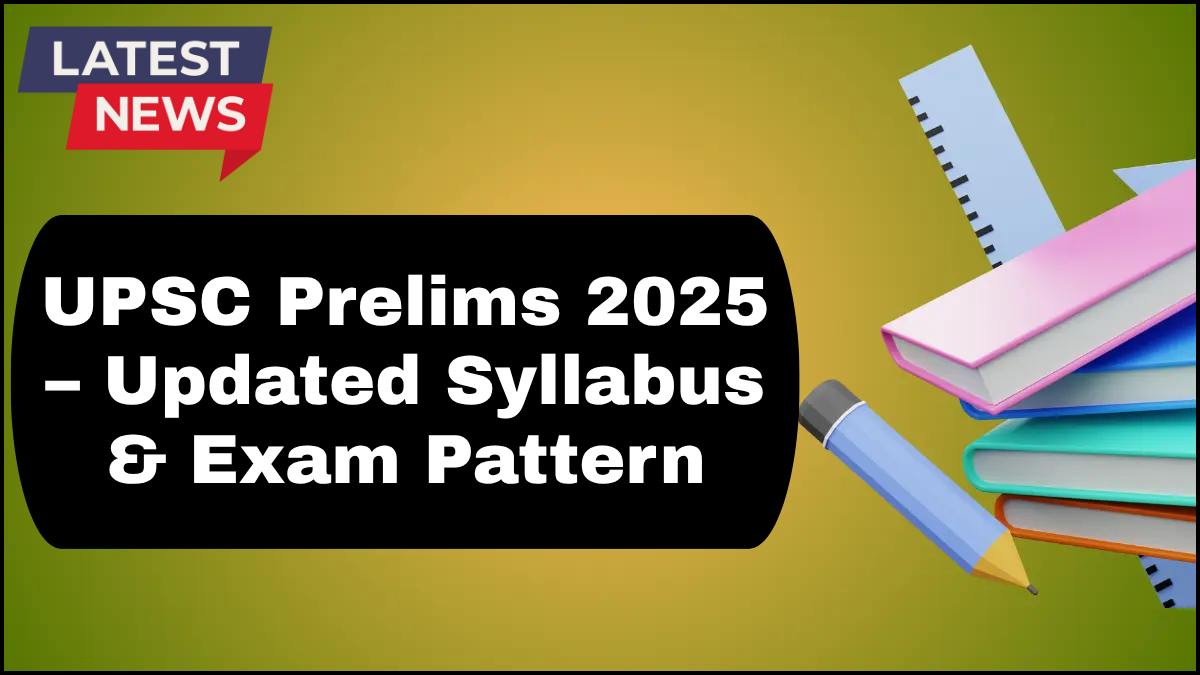The UPSC Prelims 2025 syllabus and exam pattern have undergone a few notable updates, making it essential for aspirants to reassess their preparation strategies. As the gateway to one of India’s most prestigious examinations—the Civil Services Exam—the Preliminary stage plays a critical role in shaping your journey toward becoming an IAS, IPS, or IFS officer.

Below, we break down the updated syllabus, exam pattern, and strategic insights to help you navigate this phase with clarity and confidence.
What is the UPSC Prelims?
The UPSC Preliminary Examination, commonly called the UPSC Prelims, is the first stage of the Civil Services Examination conducted by the Union Public Service Commission (UPSC). It is a screening test meant to shortlist candidates for the Mains examination. Although marks obtained in the Prelims are not counted in the final merit list, failing to clear it will disqualify you from proceeding to the next stage.
UPSC Prelims 2025 – Key Changes
While the core structure of the Prelims remains intact, UPSC has introduced some refinements in the 2025 syllabus to better evaluate candidates’ analytical skills, general awareness, and ethical understanding.
Key updates include:
-
Emphasis on conceptual clarity over rote learning
-
Broader inclusion of contemporary issues and dynamic current affairs
-
Greater weight on environment and climate change awareness
-
More situational and scenario-based questions in CSAT
These updates demand a more integrated and analytical preparation approach rather than a mere factual study.
UPSC Prelims 2025 Syllabus – Paper-wise Breakdown
The Prelims consist of two compulsory papers:
Paper I – General Studies (GS)
This paper is crucial for clearing the Prelims cut-off and covers a wide range of topics:
-
Current events of national and international importance
-
History of India and Indian National Movement
-
Indian and World Geography – Physical, Social, and Economic
-
Indian Polity and Governance – Constitution, Political System, Panchayati Raj, Public Policy, Rights Issues, etc.
-
Economic and Social Development – Sustainable Development, Poverty, Inclusion, Demographics, Social Sector Initiatives
-
Environmental Ecology, Biodiversity, and Climate Change – General issues, no subject-specific specialization required
-
General Science
Note: Questions are objective (MCQ-type) and designed to test comprehension, analytical ability, and awareness. The total marks are 200, and duration is 2 hours.
Paper II – CSAT (Civil Services Aptitude Test)
This paper is qualifying in nature. Candidates must secure at least 33% to be considered for the GS paper evaluation.
Topics include:
-
Comprehension and Communication Skills
-
Logical Reasoning and Analytical Ability
-
Decision-Making and Problem-Solving
-
General Mental Ability
-
Numeracy (Class X level) – Numbers, Data Interpretation, Averages, Percentages, etc.
-
Basic English Language Comprehension
The CSAT paper has evolved over the years to include more real-world scenarios and case-based problem-solving questions, emphasizing practical aptitude.
Exam Pattern – At a Glance
| Paper | Subject | Questions | Marks | Duration | Nature |
|---|---|---|---|---|---|
| I | General Studies (GS) | 100 | 200 | 2 Hours | Merit-based |
| II | CSAT (Aptitude Test) | 80 | 200 | 2 Hours | Qualifying |
Negative Marking: 1/3rd of the marks assigned to a question will be deducted for every incorrect answer.
How to Prepare for the UPSC Prelims 2025
To align your preparation with the UPSC Prelims 2025 syllabus, consider these strategies:
-
Current Affairs: Prioritize credible sources like PIB, The Hindu, Indian Express, and Yojana. Focus on analysis rather than just headlines.
-
Integrated Learning: Link static subjects (like History or Geography) with current developments.
-
Mock Tests & PYQs: Solve previous years’ question papers and take regular mock tests under timed conditions.
-
CSAT Focus: Don’t ignore the aptitude paper. Many candidates falter here despite strong GS performance.
-
Revision & Notes: Make concise notes and revise periodically, especially for subjects like Polity and Environment.
Common Pitfalls to Avoid
-
Over-reliance on coaching materials without understanding the concepts
-
Ignoring the CSAT paper until the last minute
-
Skipping current affairs in favor of only static topics
-
Lack of mock practice leading to poor time management
FAQs – UPSC Prelims 2025
Q1. What is the eligibility criteria for UPSC Prelims 2025?
You must be a graduate from a recognized university and meet the age criteria (21–32 years for general category, with relaxations for reserved categories).
Q2. Are there any changes in the number of attempts or age limit for 2025?
As of now, there are no official changes. General candidates get 6 attempts, OBC 9, and SC/ST unlimited (within age limit).
Q3. Does UPSC provide a syllabus PDF for the Prelims?
Yes, the official UPSC notification contains the detailed syllabus. However, aspirants often refer to expanded versions from reputed coaching institutes for better clarity.
Q4. Is the CSAT paper difficult?
CSAT has become more analytical over the years. Many find it tricky due to poor time management or lack of practice, especially in comprehension.
Q5. Can I clear the Prelims through self-study?
Absolutely. With discipline, access to quality resources, and strategic planning, self-study candidates clear the exam every year.
click here to learn more